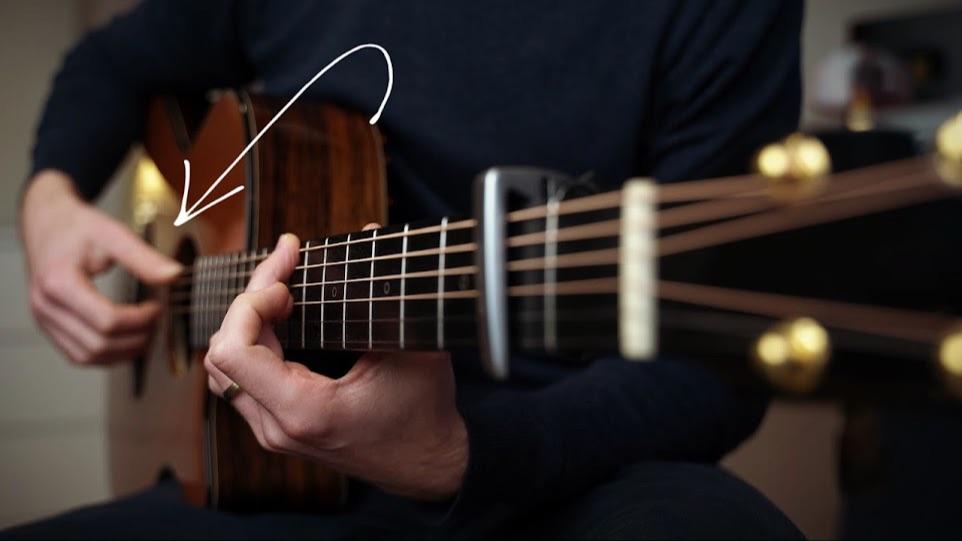Are you tired of strumming the same old chords on your guitar like a rusty old cowboy on a dusty porch? It’s time to step up your game and become a fingerstyle maestro with our beginner’s guide to chord melodies. Say goodbye to boring strumming patterns and hello to intricate and mesmerizing fingerpicking techniques that will have your fingers dancing across the strings like never before. Get ready to unleash your inner guitar god and take your playing to a whole new level.
Contents
- 1 Understanding the Basics of Fingerstyle Guitar
- 2 Exploring Chord Melodies: The Foundation of Fingerstyle
- 3 Developing Your Finger Independence for Melodic Playing
- 4 Techniques for Enhancing Tone and Clarity in Fingerstyle Guitar
- 5 Incorporating Bass Lines into Your Chord Melodies
- 6 Navigating Complex Chord Changes with Ease
- 7 Practice Strategies for Mastering Fingerstyle Guitar
- 8 FAQs
- 9 Rock on, Fingerstyle Warriors!
Understanding the Basics of Fingerstyle Guitar
So you’ve decided to dive into the world of fingerstyle guitar playing – congratulations! It’s a beautiful and versatile technique that allows you to create rich, dynamic sounds with just your fingers. Before you start shredding like a pro, let’s go over some basics to ensure you’re on the right track.
First and foremost, **fingerstyle guitar** involves plucking the strings with your fingers instead of using a pick. This allows for greater control over dynamics and tone, giving your playing a more nuanced and expressive quality.
Next, let’s talk about **finger placement**. Each finger on your picking hand (typically thumb, index, middle, and ring) should be assigned to a specific group of strings. This ensures that your playing is efficient and allows you to play complex chord voicings and melodies with ease.
Finally, **practice makes perfect**! Like any skill, mastering fingerstyle guitar takes time and dedication. Start slow, focus on proper technique, and gradually increase your speed and complexity. With patience and perseverance, you’ll soon be fingerpicking your way to guitar greatness!

Exploring Chord Melodies: The Foundation of Fingerstyle
So, you’ve decided to dive into the magical world of fingerstyle guitar playing, huh? Well, get ready to have your mind blown because today we’re going to explore the foundation of fingerstyle: chord melodies!
Picture this: you’re strumming away on your guitar, feeling pretty good about your skills, when suddenly you hear someone playing a beautiful melody while simultaneously accompanying themselves with chords. Mind = blown. That, my friend, is the magic of chord melodies.
But before you get too excited, remember that building a strong foundation is key. Just like how a house needs a solid base to stay standing, your fingerstyle playing needs solid chord melodies to soar. So, grab your guitar, dust off those fingertips, and let’s get to work!
First things first, let’s talk about the importance of knowing your chords. Chords are like the building blocks of music, and you can’t build a killer chord melody without them. So, practice those chord shapes until they’re second nature. And hey, don’t be afraid to get a little creative with them! Mix it up, add some color tones, and let your personality shine through in your chord melodies. Trust me, it’ll be worth it.
Developing Your Finger Independence for Melodic Playing
Got fingers that feel more tangled up than a plate of spaghetti noodles when trying to play a melodic line on your instrument? Fear not! Developing finger independence is a skill that can be learned with some patience and practice.
Here are a few quirky exercises to help you on your quest for finger freedom:
- The Spider Walk: Pretend your fingers are spiders crawling up and down your instrument. Start with one finger and gradually add more, ensuring that each finger moves independently of the others.
- The Alien Invasion: Imagine your fingers are being controlled by aliens from outer space. Make each finger move in a different direction, creating weird and wacky patterns on your instrument.
Remember, developing finger independence takes time and dedication, so be sure to practice these exercises regularly. Soon enough, you’ll be playing melodic lines with the grace and finesse of a professional musician!

Techniques for Enhancing Tone and Clarity in Fingerstyle Guitar
Fingerstyle guitar is a beautiful art form that requires precision and finesse to achieve optimal tone and clarity. Here are some hilarious techniques to help you elevate your fingerstyle game:
- Use your Ninja fingers: Pretend you are a stealthy ninja sneaking up on your guitar strings. Lightly touch each string as if you were trying to avoid setting off an alarm. This delicate touch will enhance the clarity of each note.
- The Jedi Mind Trick: Use the force to guide your fingers to the right strings. Feel the energy flowing through you as you effortlessly produce crystal-clear tones. Remember, “May the clarity be with you!”
- The Cat Whisker Technique: Imagine your fingers are like delicate cat whiskers, lightly brushing against the strings. This gentle touch will produce a purr-fectly balanced tone that will make your audience beg for more.
So, next time you pick up your guitar, channel your inner ninja, Jedi, or even cat, and watch as your fingerstyle playing reaches new levels of tone and clarity. Remember, a little humor goes a long way in enhancing your music!

Incorporating Bass Lines into Your Chord Melodies
When it comes to creating rich and dynamic chord melodies, incorporating bass lines can take your playing to a whole new level. By adding in a funky bass groove to your chord progressions, you can add depth and complexity to your songs.
One great way to incorporate bass lines into your chord melodies is to use the technique of bass walks. This involves playing individual bass notes that connect your chords together, creating a smooth and seamless transition between each chord. Try experimenting with different patterns and rhythms to find what works best for your song.
Another fun way to spice up your chord melodies is to play bass notes in between your chord strums. This technique adds a percussive element to your playing and can really drive the rhythm of the song. Experiment with different strumming patterns and vary the placement of the bass notes to keep things interesting.
Remember, the key to is to keep things balanced. You don’t want the bass to overpower the chords, but rather enhance them and add depth to your playing. So go ahead, get funky with your bass lines and watch your chord melodies come alive!
So you want to be the ultimate chord change master, effortlessly gliding through even the trickiest progressions like a musical ninja? Well, you’ve come to the right place! Here are some tips and tricks to help you navigate those complex chord changes with ease:
First things first, make sure you have a solid understanding of the chords themselves. Familiarize yourself with the shapes and finger positions so that you can switch between them without even having to think about it. Practice them until your fingers move with the agility of a caffeinated spider monkey.
Next, work on your transitions. Smoothly moving from one chord to the next is key to making those complex changes sound seamless. Practice shifting your fingers in a fluid motion, like a magician performing a disappearing act. Remember, the goal is to make it look effortless, even if you’re secretly sweating bullets on the inside.
Don’t be afraid to experiment with different voicings and inversions. Sometimes, changing up the positioning of the chords can make a challenging progression much easier to play. Think of it like solving a musical Rubik’s Cube – except instead of colors, you’re manipulating notes and chords with the finesse of a seasoned pianist.
Practice Strategies for Mastering Fingerstyle Guitar
So, you want to master fingerstyle guitar? Well, you’ve come to the right place! Here are some practice strategies that will have you fingerpicking like a pro in no time:
1. Start Slow: Rome wasn’t built in a day, and neither will your fingerpicking skills. Take it slow at first and focus on getting the technique right before you start speeding up.
2. Focus on Accuracy: It’s not about how fast you can play, but how well you can play. Make sure each note is clear and distinct before moving on to the next.
3. Learn Some Fingerstyle Songs: Practice makes perfect, so pick a few fingerstyle songs that you love and use them as a way to practice your skills. Plus, it’s more fun than just playing scales over and over again!
4. Experiment with Different Fingerpicking Patterns: Don’t be afraid to try out new fingerpicking patterns. You never know what might work for you!
FAQs
How can I improve my fingerstyle technique without getting frustrated?
Just remember, even the greats had to start somewhere. Don’t be too hard on yourself if you can’t get it perfect on the first try. Take it slow, practice regularly, and remember that practice makes progress, not perfection.
Do I need long nails to play fingerstyle guitar?
While long nails can be helpful for certain techniques, they are not a requirement for fingerstyle guitar playing. Many players use finger picks or simply use the pads of their fingers. Experiment with different techniques to find what works best for you.
How do I transition smoothly between chords in a chord melody?
Practice, practice, practice! Start by practicing each chord separately, then gradually bring them together. Focus on keeping a consistent rhythm and hand position to ensure smooth transitions between chords.
Are there any tips for creating my own chord melodies?
Yes! Start by experimenting with different chord voicings and inversions to create interesting harmonies. Don’t be afraid to mix up the order of the chords or add in passing tones for extra flair. And most importantly, let your creativity flow and have fun with it!
Can I use a capo when playing fingerstyle guitar?
Absolutely! A capo can be a great tool for changing the key of a song or experimenting with different chord voicings. Just make sure to adjust your fingerings accordingly to accommodate the capo position.
How can I add dynamics and emotion to my chord melodies?
Focus on varying your picking intensity, adding in slides and bends, and experimenting with different strumming patterns. Pay attention to the mood of the song and adjust your playing accordingly to convey the emotion effectively. And don’t forget to play from the heart!
Rock on, Fingerstyle Warriors!
Congratulations on embarking on your fingerstyle guitar journey! Remember, Rome wasn’t built in a day – so don’t get discouraged if your fingers feel more like clumsy sausages than nimble instruments of sonic beauty. Keep practicing those chord melodies, and one day you’ll be fingerpicking like a pro.
So grab your guitar, strike a chord, and let those melodies soar. And remember, it’s not about the destination – it’s about the fingerpicking journey. Keep rocking on, Fingerstyle Warriors!



